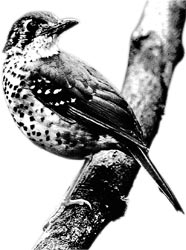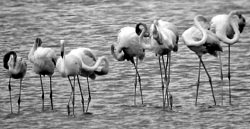
Monitoring and protecting feathered migrants“Please switch off the outside lights on your skyscrapers after 11 p.m.” read the note to owners of skyscrapers in Chicago. No, it was not an Al-Quaeda threat but a request made by the Chicago Audubon Society, a bird conservation society in the USA whose aim was to save thousands of migrant birds that are attracted to the lights and are killed when they collide with the buildings. Chicago is located in the centre of a mass migration flyway within the American continent and billions of birds fly over the city to warmer grounds and back. It is believed that birds use the light of the stars and moon to help them navigate during their long journeys, and artificial lights can confuse them.
“Migratory birds, however, are good at navigation and can find their path with great accuracy using different mechanisms. Some birds are migrating to the same location annually which is known as site-anacity. While conducting research in Sinharaja, our team had ringed a few migrants who are territorial. Next year the birds were recaptured at the same locations. A Brown-breasted Flycatcher, Brown Shrike and an Indian Blue Robin were among those who confirmed the migrant’s acute navigation skills,” said veteran ornithologist Prof. Sarath Kotagama who has studied migrants for decades. However, in Sri Lanka, migrant birds are not studied systematically and indeed more research is needed to monitor this amazing phenomenon. The Department of Wildlife Conservation (DWC) and the Field Ornithology Group of Sri Lanka (FOGSL) have initiated a ringing programme in Bundala to study migratory patterns and have conducted several ringing sessions. In the last week of July during the traditional non-migration season, the team captured and ringed 22 migrant species. “Even last year we observed a trend in early migration. Some migrants do not go back to their breeding grounds and there is a chance that some of these observed are such birds. We need hard evidence, however, that it can be an early migration,” said Chinthaka Kaluthota, coordinator of the Important Bird Areas (IBA) programme for Sri Lanka. He led the ringing session. Satellite Tracking is the latest technology being used to monitor migrants. The Pacific Shorebird Migration Project is using this latest technology to track migration of Bar-tailed Godwits. The birds were fixed with a micro chip and anyone can observe the position and route of each bird daily by logging into the website www.werc.usgs.gov. Saving the Migratory birds Migration is often concentrated along well established routes known as flyways. Environmental disturbances in strategic points along the flyways can affect migratory birds, even though the breeding ground and wintering grounds are protected. Some birds have to stop on their way and destruction of such a site may badly affect them.
Recognizing this, the United Nations’ Environmental Programme (UNEP) has prepared a convention to protect migratory birds. The Convention of Migratory Species (CMS) which was signed in Bonn is the main framework for protecting migratory species. Sri Lanka has also signed this treaty and the Department of Wildlife Conservation has the responsibility of leading the conservation effort. Destruction and degrading of wetlands remains the key threat to migrant birds in Sri Lanka. Why Sri Lanka? Sri Lanka is the last tip of the larger land mass and this strategic placement attracts over 200 migrants. Birds start migrating into Sri Lanka usually at the end of August and stay in the country until late March. Some of these birds are very common and can even be observed in metropolitan cities like Colombo. However, the greatest congregation of migrant birds occurs in wetlands like Bundala. Migrants are further categorized and a few of these birds were seen on very rare occasions. The following migrant birds are listed in IUCN’s fauna inventory, the migrants are listed in the tables below:
|
|||||||||||||||||||||||||||||||
|| Front
Page | News | Editorial | Columns | Sports | Plus | Financial
Times | International | Mirror | TV
Times | Funday
Times || |
| |
Copyright
2007 Wijeya
Newspapers Ltd.Colombo. Sri Lanka. |

